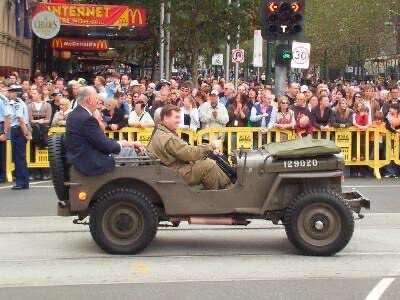
Anzac Day parade in Melbourne.
Previous Owners.
I had documentation as far back as a Victorian
owner. He had it on club rego which expired in 2012. He was on the log
book scheme, and the log book was included, along with a number plate.
He had done only two trips for 2011-2012.
After this, date unknown, the Jeep was
sold to its next owner in QLD. It was then sold, in 2021, to the previous
owner in NSW. He did quite a lot of work to it and the intention was to
have it on full rego. This was attempted in January 2024, but it failed
on several things:
Oil leaks, indicators not working, steering
wheel play, spring bracket not welded. The Jeep was put up for sale soon
after, and remained for sale for 11 months before I took interest. I purchased
it in August 2025.

Anzac Day parade in Melbourne.
The Jeep.
The Army Registration Number, 129020 while
extant in records, did not match up to the recorded engine or chassis numbers.
Similarly, the chassis number did not match the recorded ARN.
My guess is that the Jeep was rebuilt
with a mixture of parts after it entered the civilian world.
The tub is a 1941 or early 1942 Willys.
This is evident by "Willys" being embossed on the rear. The absence of
a glove box could indicate it's November 1941 to February 1942. However,
this is not certain yet due to the right hand drive conversion. Behind
the dash it looks like there could have been a glove box, but it
will be necessary to compare with a LHD drive Jeep of the same era.
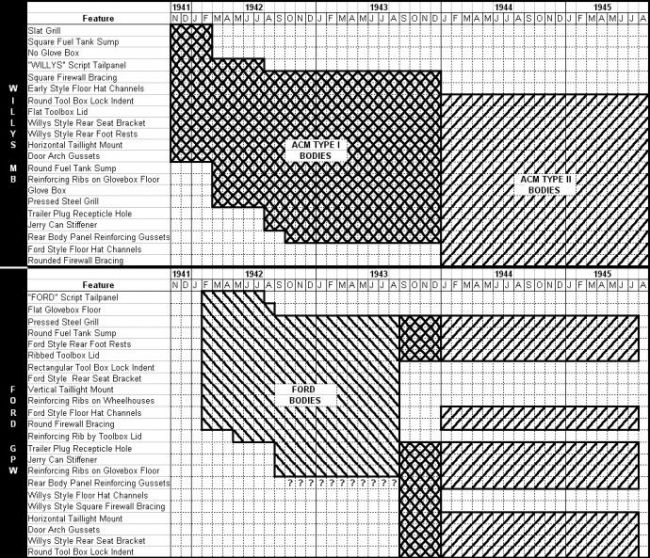
Chart shows changes over the years of production.
The engine is a Willys from 1944. It has a post-war cylinder head - this being evident because it has "Willys Jeep" cast into it. The engine number is not prefixed by "MB", which could suggest it was from a non-automotive application, such as a generator.
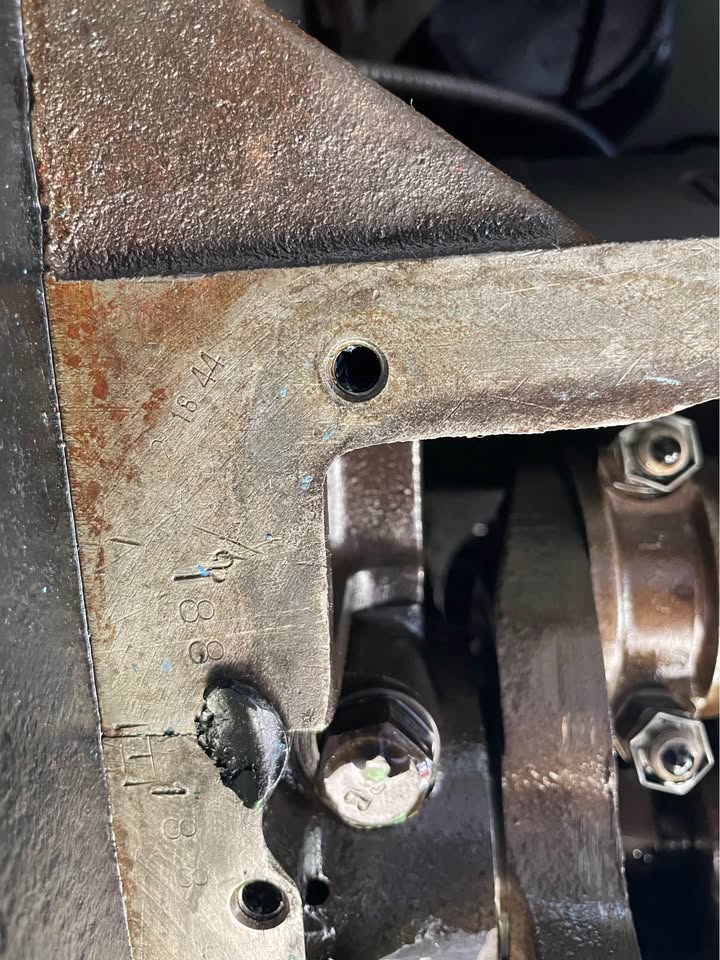
18th February 1944 casting date.
The chassis is Ford GPW, as evident by
the square section front cross member. The drive train components, except
for the gearbox, have GPW part numbers, and there are numerous "F" scripted
parts throughout. The gearbox is an early Willys, as evident by the drain
and fill plugs being on the right hand side. These were later moved to
the LHS for better access.
One of the Australian Army modifications
was an extra set of latches at the rear of the bonnet. Mine has one of
these still present on one side, with holes present on the other side.
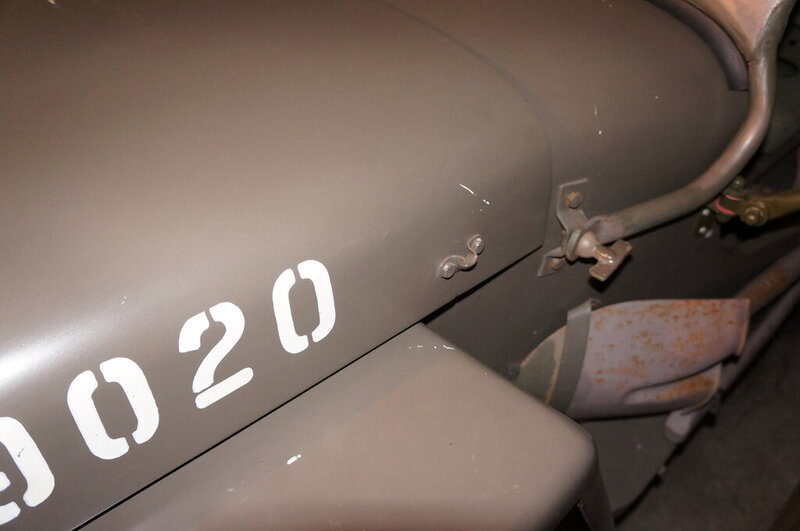
Extra bonnet latch was an Australian modification.
The jerry can holder is not original to the early body, and has been added by a previous owner. The ARN can be seen painted under where it is mounted.
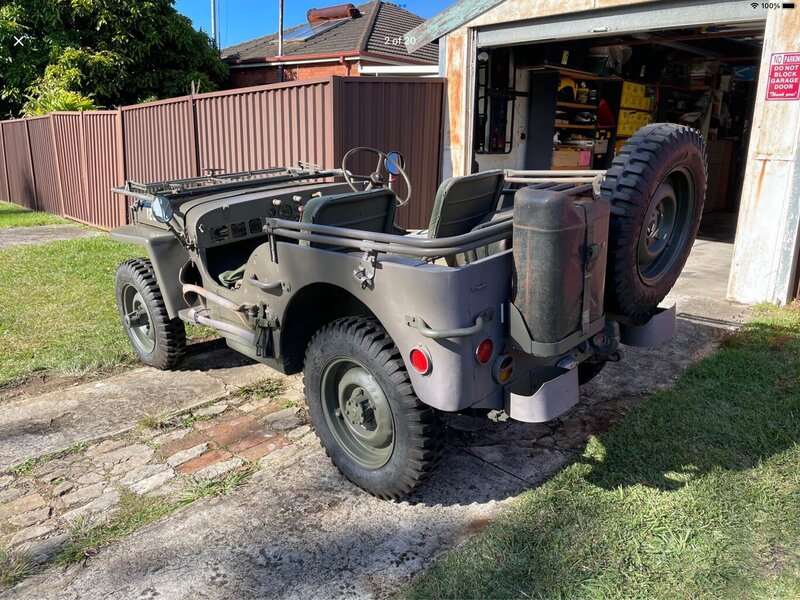
Note the white "1" right next to the jerry can holder.
Right Hand Drive Conversion.
The most obvious thing about this Jeep
is the RHD conversion. Many Jeeps were converted in their civilian life,
since Australian state governments had an aversion to LHD vehicles. My
Jeep entered civilian life in Victoria, and in that state RHD conversion
was compulsory to obtain registration. Surviving LHD Jeeps seem to be more
common in NSW, where conversion was not required. Jeeps were never converted
in their military life.
The conversion in my instance has been
very well done. In fact, I would dare say that had there been a factory
modification issued, it would have been along the same lines.
As far as converting the dash is concerned,
the switches, including that of the brake lights, have been moved to the
RH side. This meant that the wiring harness had to be modified since the
existing wiring lengths were too short. Little remains of the original
harness - most of what remains is in the engine bay.
The choke control, and presumably what
was the hand throttle, were also moved across. The latter has been deleted
due to the carburettor no longer being original, but its hole is present
in the dash.
The starter switch is in the original
position, as are the gauges, dash lights, and handbrake. The ignition switch
is not original and has a semi-modern look about it. Added to the dash
were two indicator lights - one with a blue lens to show high beam, and
the other with a green lens showing the indicators were in use. Judging
by the wiring and crimp terminals used, the conversion could have been
done in the late 60's or later.
The three data plates were moved to the
LH side where the previous switch holes, and indentation for the steering
column have been filled in. The data plates appear to be reproduction,
since no details of the actual Jeep are stamped into the Willys plate.
The steering column has been moved to
the equivalent location on the RH side. A plate has been welded behind
the dash to support the steering column, and is shaped in the original
way. Given the size of this plate, it could also have blanked off an original
glove box. Behind the dash in this area is some ribbing, which looks like
it may have been associated with a glove box. However, given the early
date of the tub, it's quite in order to pretend it is a Slat Grille body,
even if it isn't.
Plates have been welded or riveted to blank the steering column and pedal holes on the LH side. The throttle pedal foot rest has been deleted and replaced by a bolt. The original brake master cylinder access cover has been left in situ. New holes were cut for the steering column, clutch and brake pedals, and throttle pedal linkage in the RH side floor. Also moved was the headlight dip switch.
Steering.
The steering box is the standard Ross
T12 type.
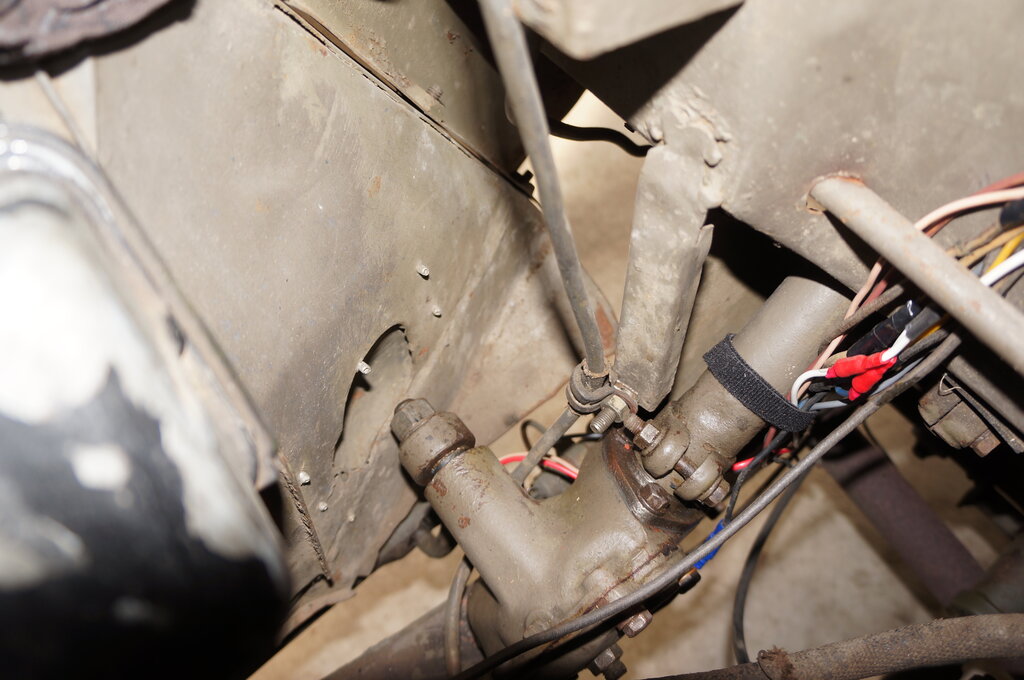
Ross T12 steering box relocated to left side of RHS chassis rail.
It has been moved to the RH chassis rail, and bolted with the three bolts as normal. The previous two tie rod with 'bell crank' system has been done away with. Now there is a single tie rod.
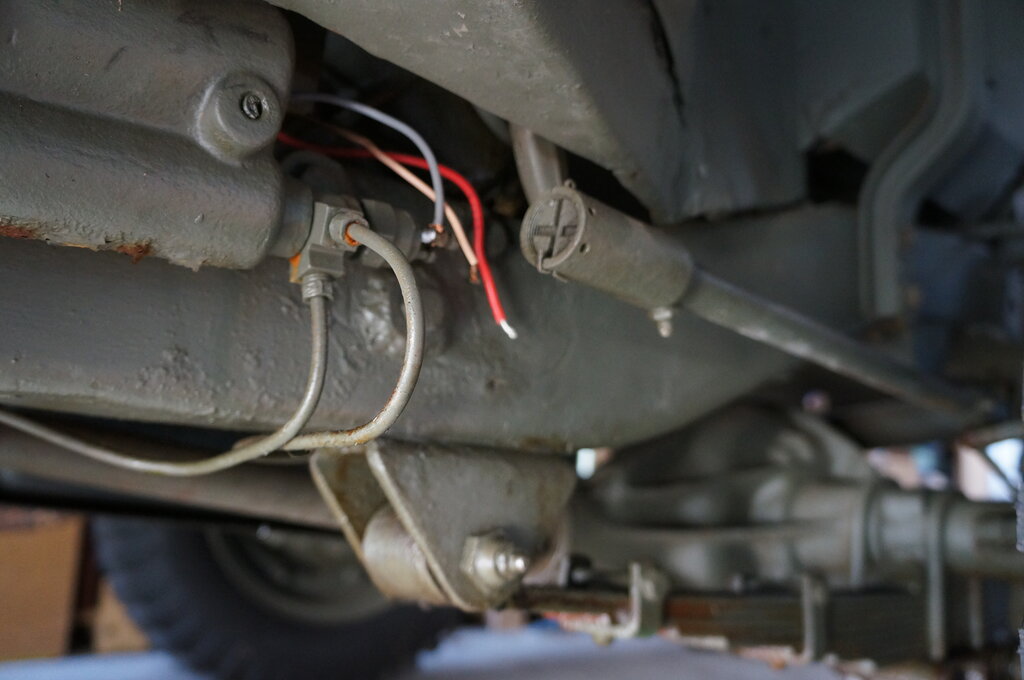
Pitman arm from steering box connects to this drag link. Brake master
cylinder to left.
The pitman arm on the steering box connects to the RH side steering knuckle via a drag link. The connection to the steering knuckle is done by a steel plate fabricated specially for the purpose. To give clearance for this when the steering is turned to the right, the adjacent shock absorber has had its upper mount moved forward on the chassis rail.
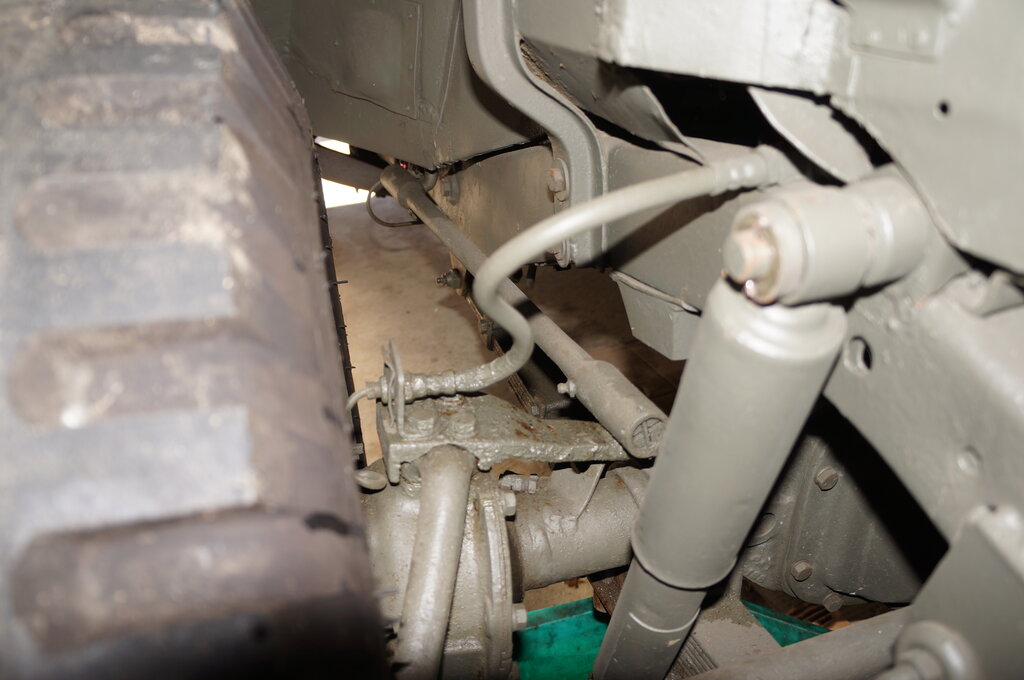
Drag link connects to fabricated plate bolted to top of steering
knuckle. Note the upper shock mount moved forward to give clearance to
the new steering arm.
It mounts under the existing four king pin bearing bolts.
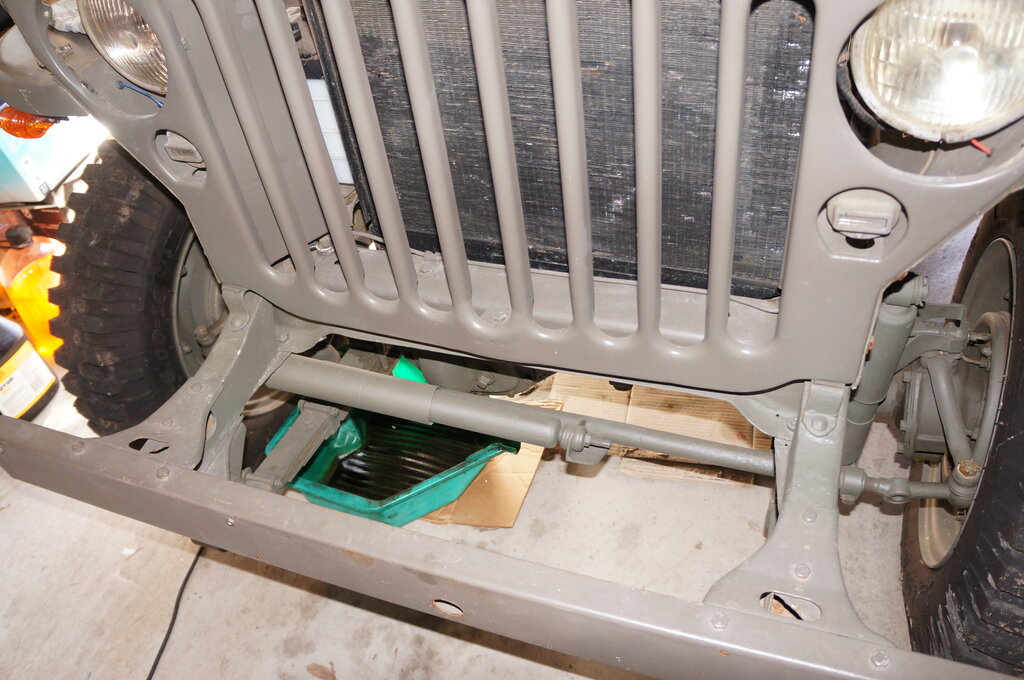
Steering damper is a shock absorber.
A damper, in the form of a shock absorber, has been added between the RH chassis rail and tie rod.
Brakes.
The master cylinder was relocated to the
other side of the RH chassis rail, and bolts in with the same two bolts.
The front braking system has been completely rebuilt to suit the relocation
of the master cylinder. From the master cylinder, the front brake lines
are fed from a T junction on the RH chassis rail. These feed the wheel
cylinders via flexible hoses. The front axle no longer supports any brake
lines, except those which go directly to the wheel cylinders.
The solid brake line to the rear has been
fabricated to suit. From its connection to the rear flexible hose, the
system is standard.
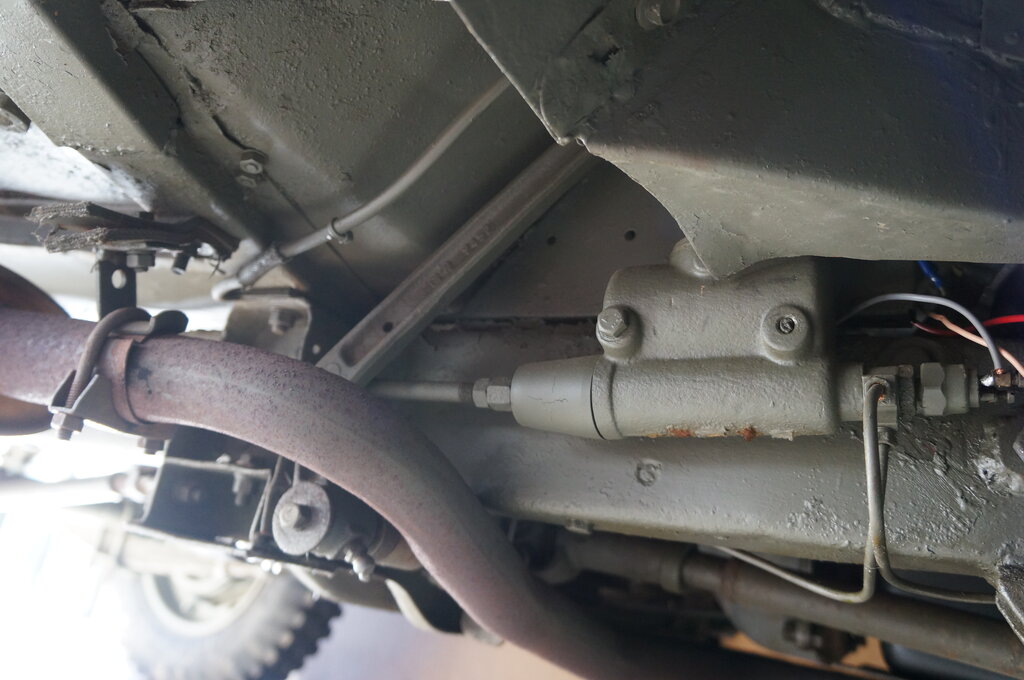
Master cylinder moved to right side of RH side chassis rail.
Clutch.
The clutch pedal is linked to the release
mechanism on the LH side by a steel tube which runs under the gearbox.
The brake and clutch pedals are in their equivalent positions in the floor.
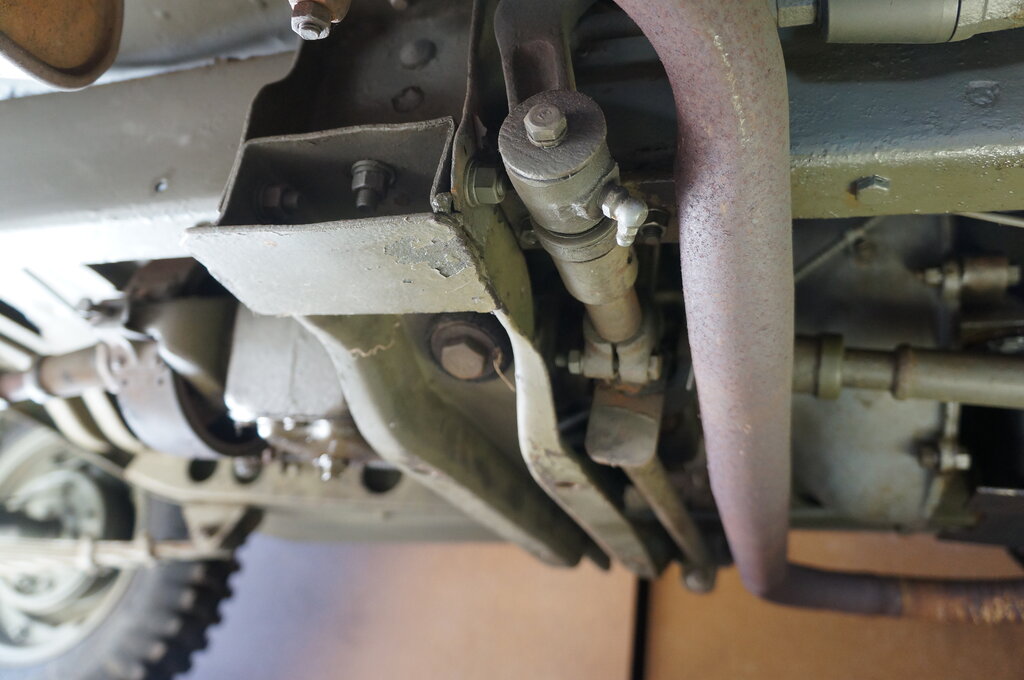
Steel tube runs under gearbox to original clutch release mechanism.
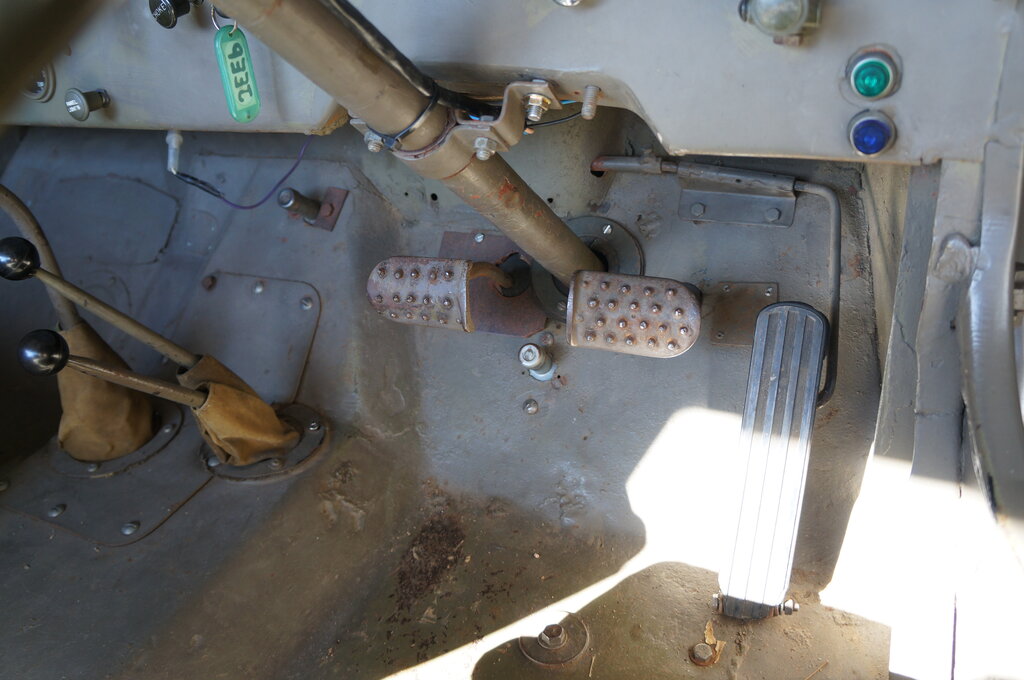
Clutch and brake pedals are in their normal positions relative to
the steering column. Dip switch is between clutch and brake pedals.
Throttle.
The photo above shows how the throttle
pedal is now vertical. This is because of the different geometry of the
two footwells. There is not enough room for it to be on a slight angle
off vertical as per original. Also visible is the linkage which enters
the firewall just above the steering column. The throttle pedal is not
original.
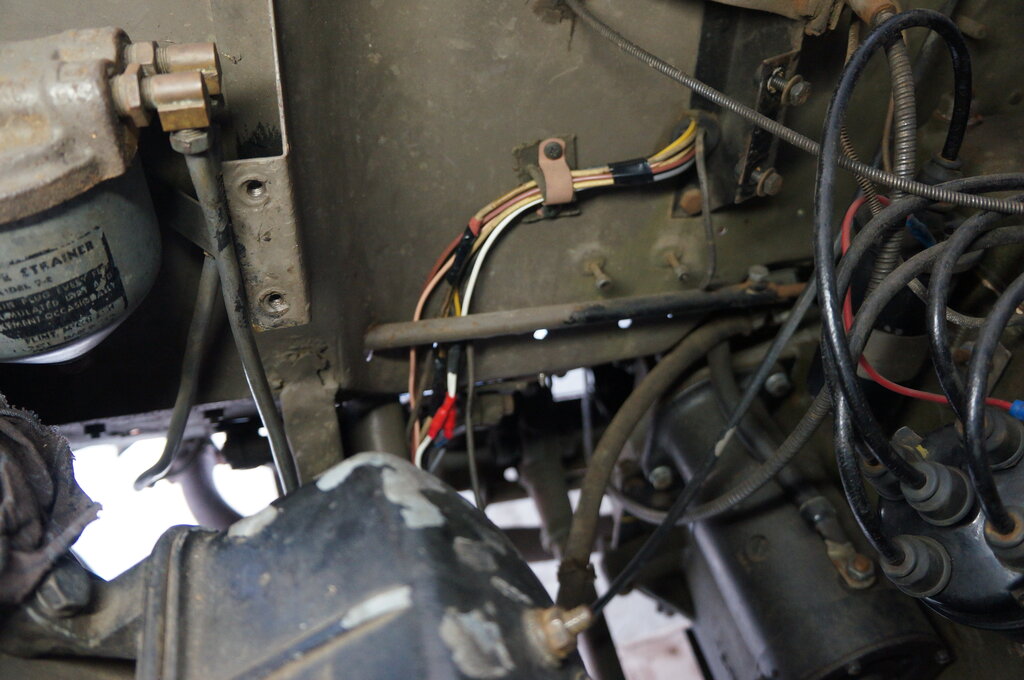
Throttle linkage can be seen running across firewall with the wiring
behind it.
The choke cable was relocated to the right side of the dash, but otherwise unchanged.
Not the first RHD Conversion.
The first thing that alerted me to this
RHD conversion not being the first one this Jeep has had, was the exposed
stud next to the steering column mount. The upper section of the steering
column support bracket had also been modified so it could be shifted slightly
to the left.
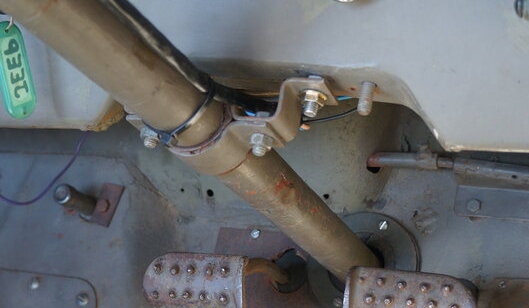
Note unused stud to the right. Steering column has been shifted
to the left.
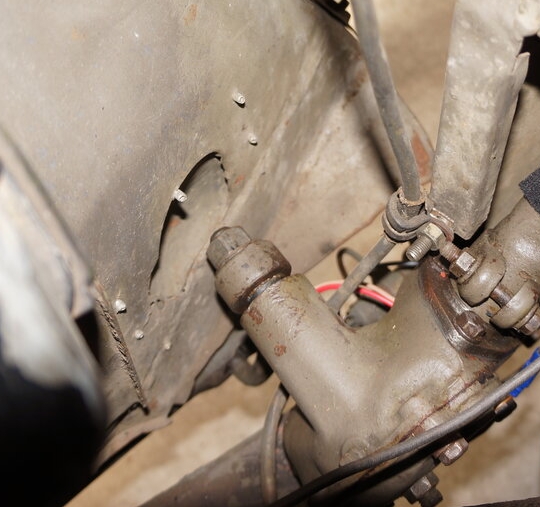
Hole in fender wall not required with present conversion.
It had also been noticed that a hole had been cut in the fender wall to accommodate the pitman arm. I had seen some RHD conversions where this was the case, but here, with the present steering box it was unnecessary. This is suggestive of a different steering box once having being used here.
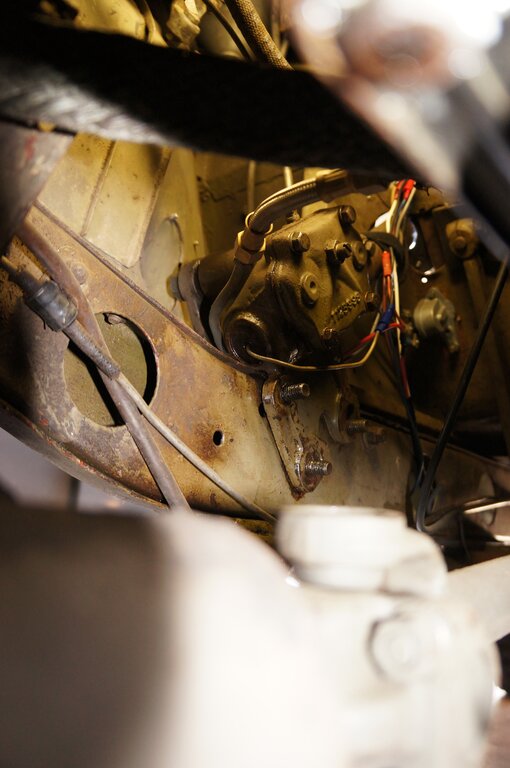
Horn wire can be seen emerging from bottom of steering box.
The next thing was the horn wire. For the
MB/GPW Jeeps, the horn connection is via a brush on the steering column.
This makes contact with a slip ring on the steering shaft, which then connects
to the horn button in the centre of the steering wheel.
However, what I had here was a wire emerging
from the bottom of the steering box. This indicated a CJ steering box.
Even though both are Ross T12, the later Jeeps have a hollow tube which
runs up part way into the steering shaft. All the steering box parts are
otherwise the same. The difference is that, apparently, the steering shafts
are different lengths after a certain date. This is something I need to
check should I replace the steering shaft. The original MB/GPW and early
CJ are 40.5" long.
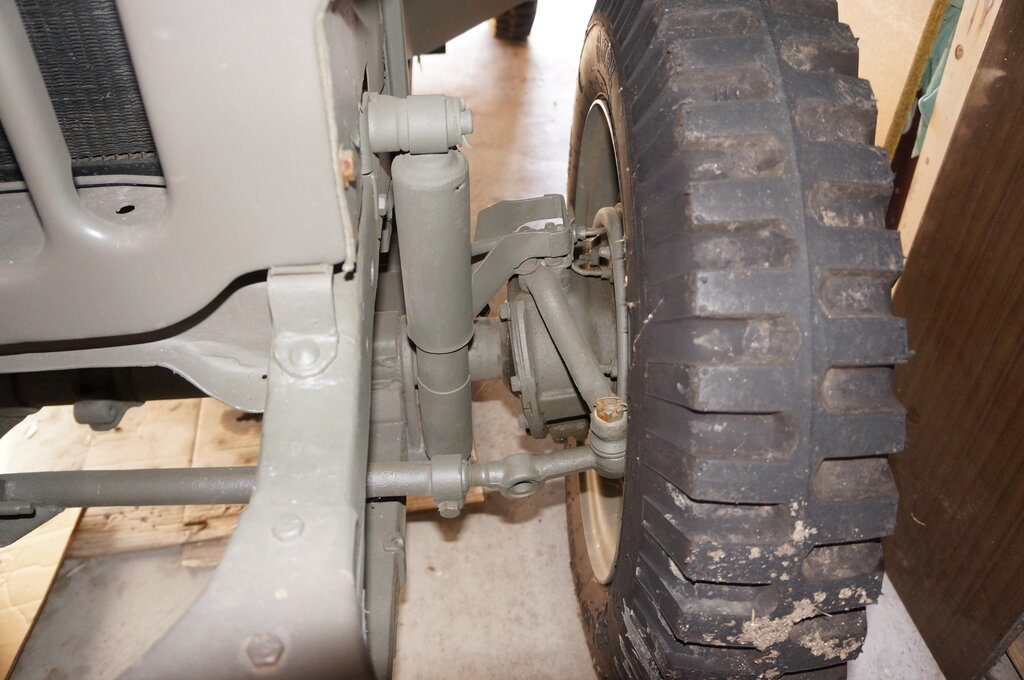
Tie rod end is from a CJ.
Another interesting thing is the LHS tie
rod end. The unused connection adjacent to the threaded part had me curious.
It turns out this too is from a CJ and was used for the drag link connection.
From what I've been able to deduce, this was a feature on 1972 to 1986
models.
It could well be that the tie rod is also
CJ (which would make sense since it would be the correct length), as well
as the drag link. I only have to find the measurement from a CJ drag link
to confirm it's all CJ parts.
Furthermore, there's a plate riveted over a hole in the floor adjacent to the throttle pedal. This suggests a different linkage to the carburettor was part of the original conversion.
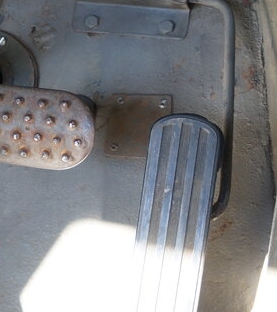
Note the square plate between brake and throttle pedals.
The question is why, and what was the original conversion? One can only assume that whatever it was provided poor steering.
Civilian Use.
Indicators have been fitted. A Hella 4208
indicator switch was mounted on the steering column. It feeds a thermal
flasher mounted under the dash. Hella indicator lights using 18W festoon
bulbs have been added under the front guards. An electric wiper with switch
on the dash had also been added. The electric wiper had been removed by
the previous owner, and replaced with the original type hand wipers. The
switch is still present.
A number plate light has been added at
the rear. A civilian trailer socket had been added.
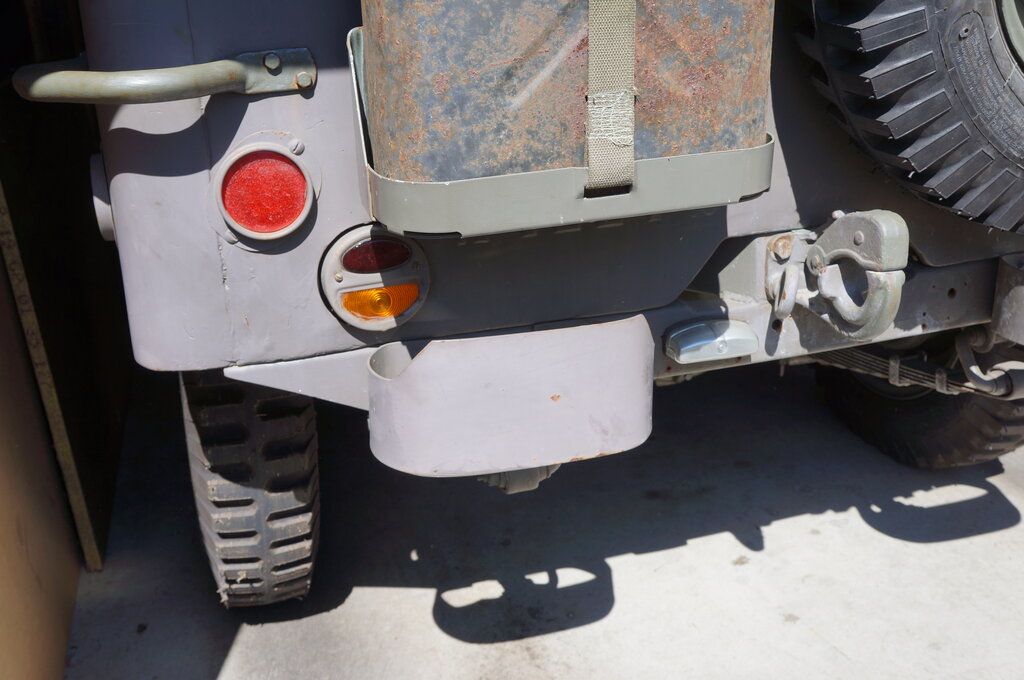
Brake/park and indicator light. Number plate light adjacent to Pintle
hook.
The rear lights have been modified to function in the familiar pattern of brake/parking behind a red lens, and indicators behind an amber lens. The brake/parking bulbs are standard twin filament types with staggered pins. The indicator bulbs are single filament, single contact types. The red lenses appear to have been obtained from the original sealed beam bulbs, and secured in place with silastic. The amber lenses appear to have been cut from indicator lights off a civilian vehicle, and again silastic secures them in place. Since the bulbs are no longer sealed beam, a dividing partition cut from tin has been placed between the two sections of the lamp housing. This is necessary so the light from each bulb shows only through the appropriate lens. Again, the tinplate is secured with silastic.
The headlight switch has been reconnected so it is compatible with this arrangement, and for more of a civilian feel in operation. The blackout marker lights on the front function as parking lights.
